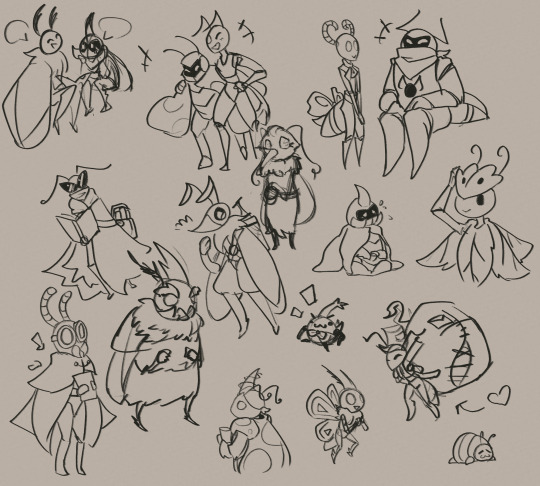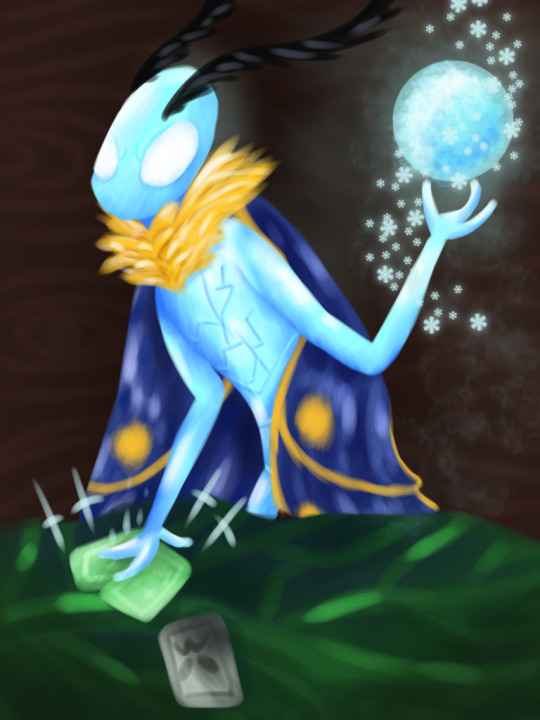#janet bug fables
Explore tagged Tumblr posts
Note
Janet, with a redesign (and by that clothes)

dont give me the option of clothing bc i WILL give you a poncho
#most of the ants have really simple designs#so its free real estate to do what i want :]#i am running out of 'card holding' poses lmao#janet bug fables#bug fables#fanart#digital art#anonymous#my art
56 notes
·
View notes
Photo

[image description: a page full of sketches of bugaria residents mostly standing about: Neo and Kabbu together, Levi and Celia, Zaryant and the Termacade worker, Reeves, the Dark Cherry Vendor, Samira, the Scared Beetle, Eophi, Wedge, Fuzzo, Doppel, Tod, Tanjerin, Janet, my beloved, and a pibu below. end id]
bugaria lads, trying them out probably switch it up a bit
#bug fables#kabbu bug fables#professor neolith#bugaria residents#janet bug fables#tangerin bug fables#fuzzo bug fables#levi and celia#zaryant bug fables#Reeves bug fables#dark cherry vendor#samira bug fables#Eophi bug fables#wedge bug fables#doppel bug fables#tod bug fables#pibu#draw more bugs! draw more bugs!!
139 notes
·
View notes
Text

Champion
#my art#lineless#bf leif#bug fables#alt titles:#pov youre janet#hes trying to fight you. yes you. the viewer.#bug fables leif#leif bug fables#leif#im adding ALL the tags because im super proud of this#leif the moth
75 notes
·
View notes
Text
So watching an LP and team Snakemouth is way more savage than I remember.
3 notes
·
View notes
Photo

saw at least one other person doing this and decided to go crazy about it
[Image Description: a page displaying various bug fables lgbt+ headcanons. On the left are two columns of three individual character sprites each, with pride flags and pronouns to their right.
Vi: the sunset lesbian and genderqueer flags. a big scribble then “(it’s complicated).” Leif: the genderfluid and bi flags. “he/she/they but could be anything depending.” Kabbu: the trans and bear flags. “he/him”
Zasp: the bi and trans flags. “he/him.” Mothiva: the lesbian, grayromantic, and graysexual flags. “she/her.” Mothiva and Zasp have a line between them labeled “I’d have to write a paragraph but in summary: yikes.” There’s also a line going from Mothiva to a small sprite of Jaune with a heart and a question mark. Neo: the mlm flag. “he/him” There’s a line between Kabbu and Neo labeled with a heart.
On the right side of the page are a number of images. The top is a large lesbian flag with Carmina, Crow, Chubee, H.B., Bea, Jaune, Rebecca, Kina, Hawk, and Muze on it. On the bottom left Crow, Arie, Serena, Carmina, and Janet’s sprites are encircled with a dotted line labeled “spy cards yuri night.�� On the right of that is text reading “everyone who shows up in the Underground Tavern: some flavor of queer (it’s also a gay bar)” next to the gilbert baker rainbow flag. Under that are Artia and Reed’s sprites with *bi flag* 4 *bi flag* above them. On Reed’s other side is a line connecting to a small sprite of Tennent labeled “exes >:3″. End ID.]
#an aquila original#'wow aquila that's a lot of lesbians' thanks it's the lesbianism. I just kind of default to it#also getting weirdly specific on some of them but whatever. havin fun#not tagging everyone because wow#will tag the ships tho bc I saw someone asking#kabbu/neo#mothiva/jaune#artia/reed#zasp and mothiva isn't really a ship here? they're a disaster not a romantic/sexual relationship#bug fables
41 notes
·
View notes
Text
My Roommate doesn't believe Athiests and Pagans are moral via /r/atheism
My Roommate doesn't believe Athiests and Pagans are moral
Okay this bugs me, I love The Magicians by Lev Grossman who made his own version of Narnia that is screwed up, but my favorite type of screwed up. It's the consequences always have a reason, if you hurt one thing you always get consequences for said actions.
My roommate the Christian found it offensive when he read and then saw the series. He said the whole system is ripping off C.S. Lewis and since Lev Grossman is athiest he doesn't understand it. How can Eliot, Janet (Margo), Julia, Quinton, and the rest be moral if they don't believe in God?
He sort of refused to read further into it and has ignored me when I told him athiests do have morals. He doesn't believe TellTale or Llyod Evens are moral even though they talk about consequences for negative actions in a cause and effect situation. He hasn't even realized how bad he is getting either because he won't listen to us. He literally refuses to believe he is the reason certain items break when he is rough with them, he turns around and says since we're Pagan (husband and I) we're just as guilty.
Case and point, roommate broken the oven, my husband and I are gentle and also warned about a power surge that fried a computer component in the oven that regulates heat. He turns around and blames us for it when he didn't ground it before installing the oven. Yet who is truly at fault? We warned him.
Other case, he brought COVID home and refused go be tested. This was back in 2020, he knew my husband had a comprised immune system. He was sent home from work when he tested positive when his work a grocery required it. He didn't tell either myself or my husband until two days later during his anti-vax vent. He literally got on me for a FLU SHOT! Of course we can't say anything about him being wrong he has MORALS and we don't according to him.
We sort of blew him off, but when we both got COVID, husband and I self quarantined and were not going outside. We literally had to have him pick up stuff to cook and he said if we believed in God and had morals...yeah he literally believes we are immoral even though we are more so than he is. (This was 2021)
He got mad when I freaking quoted Aseop's Fables about the Ant and the Grasshopper and also a few others. He literally blew off the fact he doesn't ever take his actions as immoral when he never listens to logical answers. Pagans and Athiests made more sense morally than he did and it blows his mind when I turn out to be correct and he ends up with incorrect information.
Submitted August 30, 2022 at 10:48AM by NagiNaoe101 (From Reddit https://ift.tt/YFpXDmv)
2 notes
·
View notes
Video
tumblr
CRONOS
Beautiful Dark Things By Maitland McDonagh Essays DEC 7, 2010
Guillermo del Toro understands the power of fairy tales. Not the prettified romances of Charles Perrault, who tamed the Brothers Grimm for French drawing rooms, or the charming animal fables of Aesop, or the reassuring moral lessons Disney made of “Cinderella” and “Sleeping Beauty,” but brutal tales of cruel fate, painful choices, and irreversible consequences, stories whose roots lie deep in the dark woods of our collective unconscious. Good may prevail, but there will be blood.
A melancholy modern-day spin on classic horror themes, Cronos (1993) was the then twenty-eight-year-old Mexican writer-director’s feature film debut, and it marked the arrival of a startlingly distinctive voice. Cronos was fresh without being trendy, exquisitely designed without losing sight of the fact that even the coolest creature—and the film’s cronos device, an intricately carved mechanical bug with a living core, is extraordinarily cool—can’t compensate for thinly conceived characters or a tediously formulaic narrative. It swept the 1993 Ariel awards—Mexico’s Oscars—winning in nine categories, including best picture, director, and original screenplay. A month later, it received the prestigious International Critics’ Award at Cannes, and subsequently won over festival audiences from Portugal to Russia.
That Cronos failed to generate equal enthusiasm in the United States was disheartening but no great surprise. Horror and exploitation movies can be a good way to break into Hollywood: their built-in fan base is famously forgiving of such rookie scourges as subpar/uneven acting and poor production values, so they stand a good chance of making some money, and movies that make money open industry doors. But they’re a notoriously bad way to launch a career in serious filmmaking (the illustrious Francis Ford Coppola, Jonathan Demme, and Oliver Stone notwithstanding). Cronos had two strikes against it: it was a vampire movie, and it was (mostly) in Spanish. By the early 1990s, America’s always modest but ever faithful art-film audience was aging out of existence, and for American distributors, foreign-language films were always art—people had to read in the theater, for heaven’s sake. At the same time, the theatrical exploitation market was dying: drive-ins were gone; urban renewal projects were shuttering the low-rent inner-city theaters that had once shown double and triple bills and introduced Americans to filmmakers as diverse as Stone, Dario Argento, Georges Franju, Mario Bava, Jean Rollin, and Peter Weir; and the sheer volume of direct-to-video releases virtually guaranteed that good movies would get buried by bad. The wonder is that a handful of high-profile, mainstream critics (including the New York Times’s Janet Maslin, Roger Ebert of the Chicago Sun-Times, and the Los Angeles Times’s Kenneth Turan) stumbled across Cronos and duly noted that it was no hack job, pun invariably intended.
But del Toro hadn’t made a horror movie thinking it could be a stepping stone to bigger and better things. He made Cronos because he wanted to, and kept making genre pictures long after he could have stopped. Del Toro has admitted ruefully that he kills himself doing the kind of films other people knock out for quick cash, and his devotion shows: Cronos and The Devil’s Backbone (2001) are as subtle and rich as any highbrow coming-of-age drama, and who knows what Mimic (1997) might have been had the production not been so legendarily troubled—its early scenes are magnificently eerie. Unlike many U.S. genre filmmakers of his generation, del Toro doesn’t love schlock—tacky rubber monster suits hold no sway over his imagination. He loves freaks and beasts because they’re outcasts, the flawed, damaged reflections of human nature. If there’s any filmmaker with whom he should be compared, it’s David Cronenberg, who eventually earned his ticket out of horror and uses it only when it suits him.
Born and raised in Guadalajara, del Toro was a bookish and imaginative boy, both prone to nightmares and in love with the macabre. When his father, a successful Chrysler dealer, came into some money, he invested in two sets of encyclopedias, one on art and the other on medicine, both of which his son devoured. Del Toro loved comic book art and fine art with equal passion; in his mental gallery, works by Richard Corben and Bernie Wrightson hung next to Rembrandts and Caravaggios. He drew extremely well, and like many future filmmakers, appropriated his father’s 8 mm camera as a youngster, returning it only after he had graduated to 16 mm. And then there was del Toro’s Catholic grandmother, who cast a long, dark, but richly resonant shadow over his formative years. To call her devout would be an understatement; del Toro has compared her to “Piper Laurie in Carrie.” She was less than enchanted with her grandson’s macabre warp of mind . . . so not enchanted that she exorcised him herself—twice—and lamented until her death his inability to create beautiful things. Del Toro, of course, was creating beautiful things, if not necessarily pretty or conventionally pious ones. His eye was attuned to the beauty in the darkness.
It was Pan’s Labyrinth (2006) that put del Toro on the mainstream map. Critics waxed rhapsodic, the notoriously conservative members of the Academy of Motion Picture Arts and Sciences nominated it for six Oscars, and moviegoers who would never have considered seeing Blade II (2002) or Hellboy (2004) surrendered to its dark charms. But everything that madePan’s Labyrinth so much more than a run-of-the-mill spook tale was already evident in Cronos: the dark depiction of childhood, the deep understanding of mythic imagery, and the rich, complex relationships that drive everything the characters do, for better or—all too often—for worse.
Cronos was the culmination of del Toro’s youthful experiments making short monster movies, which grew progressively more elaborate and sophisticated. They forced him to learn how to create special effects, from simple squibs to gaping wounds and fetus creatures, because there was no one in Guadalajara to do them for him. Del Toro took those skills and opened his own effects shop as a way of bankrolling Cronos. In the decade before the project finally went in front of the cameras, he also gained invaluable experience and professional connections, including working on a Twilight Zone–like TV show called Hora marcada with Alfonso Cuarón and cinematographer Emmanuel Lubezki (who would go on to collaborate on Y tu mamá tambiénand Children of Men). Del Toro and Cuarón are now partners in Cha Cha Cha Productions, along with Alejandro González Iñárritu, whom del Toro met after cold-calling him to say that he’d seen an early cut of Amores perros and it needed trimming.
Cronos is a young man’s movie (though del Toro fretted that he was a late starter), but its emotional sophistication is striking. At the film’s heart is the relationship between a reluctant vampire—aging antiques dealer Jesús Gris, played by veteran Argentine actor Federico Luppi—and Aurora (Tamara Shanath, who has made only a handful of subsequent films), the silent, watchful granddaughter who adores him. Infected with eternal life by an ancient insect hidden within an intricate clockwork one, Gris is gradually transformed into a pallid creature who must shun the daylight and drink blood to survive. He is hunted by a ruthless thug (Ron Perlman, best known then for the cultish romantic fantasy television series Beauty and the Beast,and later for del Toro’s Hellboy) whose wealthy but infirm uncle covets the cronos device, and he is degraded (dressed in dapper black tie for a New Year’s Eve ball, he can’t resist lapping blood from the men’s room floor), brutalized, and eventually killed . . . except, of course, that he can’t die, and escapes his own cremation to creep home in the pouring rain. If your heart isn’t broken by the scene in which Aurora opens the door and hands her grandpa a fluffy towel, then puts him to bed in a coffinlike toy box with stuffed animals and a plastic dolly for company, your heart is unbreakable.
Del Toro has said that were he to make Cronos now, it would be a very different film. And though that’s no doubt true, it’s hard to imagine its being a better one. In the words of the doomed alchemist who creates the gold bug and learns that immortality comes at a price: suo tempore. Everything in its time.
#cronos#the criterion collection#guillermo del toro#maitland mcdonagh#federico luppi#tamara shanath#mexico
1 note
·
View note
Photo



[image descriptions: three images. The first is of a heavily shadowed Leif standing in front of a dark cave mouth. Bits of ice float around and a shadow stretches out in front of him. Second image, Janet staring and holding a spy card. She’s in front of some balloons and some other stuff in a card shape. Last image, is a squishy Vi sitting on the floor with a drink. It reads, “Just Vi-bing: don’t @ me”]
Midnight doodles. Guys. I need the Janet lore.
#bug fables spoilers#leif bug fables#vi bug fables#janet bug fables#JANET WHAT HAVE YOU SEEN#WHERE HAVE YOU BEEN JANET#HOW ARE YOU THE MOST INTERESTING CHARACTER JANET#Janet was already my favorite npc so I was absolutely chuffed when she showed up#droowings#bug fables
175 notes
·
View notes